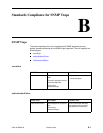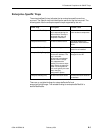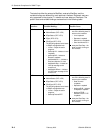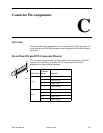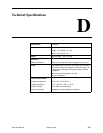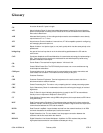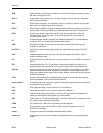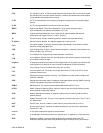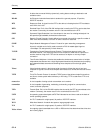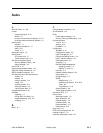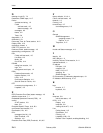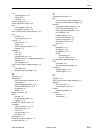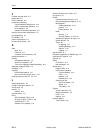
8784-A2-GB20-30 February 2001
GL-1
Glossary
511
A random bit test 511 bytes in length.
AIS
Alarm Indication Signal. A signal transmitted downstream instead of the normal signal to
preserve transmission continuity and to indicate to the rest of the network that a fault exists.
Also called a Blue Alarm.
AMI
Alternate Mark Inversion. A line coding technique used to accommodate the ones density
requirements of E1 or T1 lines.
ATI
Asynchronous Terminal Interface. A menu-driven, VT100-compatible system for configuring
and managing the termination unit.
BPV
Bipolar Violation. In a bipolar signal, a one (mark, pulse) which has the same polarity as its
predecessor.
bridged tap
Any part of the local loop that is not in the direct talking path between the CO and the
service user.
CAP
Carrierless Amplitude and Phase Modulation. A transmission technology for implementing a
DSL. Transmit and receive signals are modulated into two wide-frequency bands using
passband modulation techniques.
CD
Carrier Detect. The received line signal detector. V.24 circuit 109.
CO
Central Office/Central Site. The PSTN facility that houses one or more switches serving
local telephone subscribers.
COM port
Communications port. A computer's serial communications port used to transmit to and
receive data from a modem. The modem connects directly to this port.
CP
Customer Premises.
CPE
Customer Premises Equipment. Terminal equipment on the service user's side of the
telecommunications network interface.
CPU
Central Processing Unit. The main or only computing device in a data processing system.
CRC
Cyclic Redundancy Check. A mathematical method of confirming the integrity of received
digital data.
CTS
Clear To Send. A signal indicating that the device is ready for the DTE to transmit data.
Usually occurs in response to Request To Send (RTS).
CV
Code Violation. Detected when using HDB3 coding format, this is equivalent to a BPV when
using AMI coding.
DCE
Data Communications Equipment. The equipment that provides the functions required to
establish, maintain, and end a connection. It also provides the signal conversion required for
communication between the DTE and the network.
DCLB
Data Channel LoopBack. Loops the data received from the network interface, for all DS0
channels allocated to the selected port, back to the network.
DSL
Digital Subscriber Line. The non-loaded, local-loop copper connection between the
customer and the first node within the network.
DSLAM
Digital Subscriber Line Access Multiplexer. A platform for DSL modems that provides
high-speed data transmission over traditional twisted-pair wiring.



